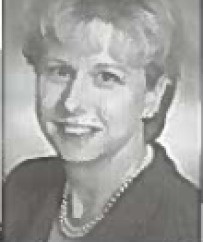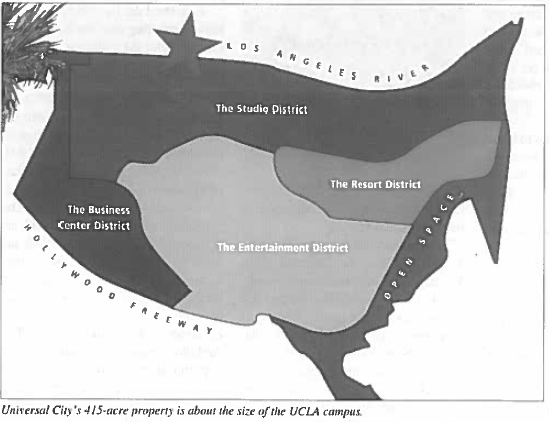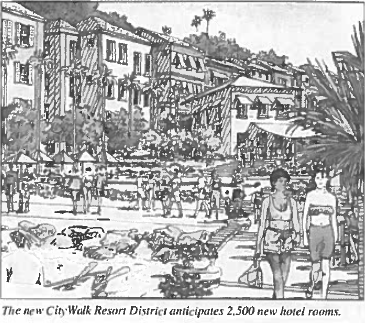Is Universal City Walk the model for the future of entertainment and retail development? MCA is counting on it as it develops a master plan for the 415-acre Universal City site, which also includes Universal Studios Hollywood and the Universal Amphitheatre. The plan, which calls for 5.9 million square feet of new development over the next 25 years, envisions four “districts” including a new entertainment theme park for children, and resort district. TPR is pleased to present an interview with Helen McCann, Vice President, Master Plan, MCA Inc. and previously Development Manager for the Fox Studio expansion in Century City.

Helen McCann: “The concept… of the plan is to build to our strengths… First and foremost is always movie-making… Second… we’ll add new offices and hotels in the business center…”
Among many other changes since last TPR visited MCA is that the ownership has changed. Could you give us an overview of the changes that have happened in the last year and a half.
As you may know, 80% of MCA was purchased by the Seagram Company Ltd. in June, 1995. The new MCA management team, under President Ron Meyer, and Chairman and CEO Frank Bondi, Jr., has a new sense of the future, and a focus on growth. The new team is committed to making the best of this property.
What does this change in ownership mean in terms of the property, design, scope and timing of this 415-acre project. Is ownership of any significance?
The real significance is the overall focus on the unification of the company on the property, serving all the various businesses here at Universal in the most efficient and cost-effective way. Fortunately, we see a continuation of the planning strategy that has been in place for the last two years. Planning continues to be very collaborative and interdivisional.
Let's talk about the master plan that MCA is developing. What are the elements of the proposed plan?
The elements of the plan are basically what is here on the property at Universal today. The concept and the philosophy of the plan is to building on our strengths and those elements that work wonderfully here today.
First and foremost is always movie-making—the studio component. We have two million square feet of studio space with just under one million square feet of new studio space planned over the next 25 years. We expect to build new sound stages, support stages and studio office space.
Second, we currently have a business center on the property. The MCA world headquarters are here, as well as offices along Lankershim Blvd and hotels along the 101 Freeway. These land uses are an important part of our business. We plan to add new offices and hotels in the business center as well.
Third, the entertainment district, serves most of our visitors. When people visit Universal City, they come to Universal Studios Hollywood, University City Walk, the cinemas, the Amphitheatre, and all the wonderful places at the "top of the hill."
We envision adding to these current uses new attractions and restaurants, as well as a complementary use—a family entertainment venue. With this new venue we hope to provide entertainment for the three to twelve year old market and serve as a family destination with the introduction of our resort district and resort hotels.
Our vision is to have a place at Universal Studios where families can come and stay for several days. We want those families to feel comfortable, have many amenities, and capture the magic of movie-making by being directly adjacent to the backlot. This new resort will have a sense of fantasy to it.
The plan calls for 5.9 million square feet of new development in four districts, which you have outlined. The newest area is the resort hotel district, which is about 2 million square feet. Would you elaborate on the plans/operations within this new district?
The resort district is envisioned to be on a portion of the property that is absolutely gorgeous, if underutilized. The land has backlot sets on it, and is adjacent to the backlot, but it has a beautiful topography and fantastic views of the Valley.
We think that this land has tremendous potential for a cluster of resort hotels that serve different components of the market. Each may have a slightly different personality, with perhaps four or five different hotels, clustered around a water element, such as a mini-beach.
What is the expected economic impact of the Master Plan for Los Angeles County/region?
Development at Universal City is a tremendous plus for Los Angeles and the region. If this project is buildout as proposed, in the year 2010, there will be about 13,000 additional jobs here at Universal City.
Incremental tax revenues are approximately $75 million to local, county and state coffers to provide public services. The economic impact is at least two billion dollars a year of incremental economic impact. Much of that impact occurs locally, because the labor pool in San Fernando Valley serves all the entertainment industry and all of the studios. We have easily the best labor pool in the world, right here. Currently, about 60 percent of the people who work at Universal City live within ten miles of the property.
What are some of the design features of the new master plan MCA has in mind?
We anticipate about 2,500 hotel rooms as part of our resort district. Our idea is to keep the best of Universal City Design features include building setback height limits, water elements, enhance entrances, pedestrian pathways and plazas and extensive landscaping and greenscapes.
Our plan at this point is conceptual—it is not designed. The word that keeps coming to mind is fantasy or magic. The resort district should feel different from any typical resort. The visitor should know that he or she is on a movie studio and part of something very special. City Walk is a good example of the design intent; the visitor really feels like he or she is somewhere unique and special.
Almost 70% of the 415- acre site is in the unincorporated part or Los Angeles County, completely surrounded by the City of L.A. What are the intergovernmental implications for sharing the development impacts?
This intergovernmental puzzle is a real challenge, but I'm happy to report that so far it has been working well. Both the City and the County have approached this planning effort as a special challenge, with a "let's roll up our sleeves and get the job done" attitude.
We have met with both the City and County to evaluate the potential impacts. The environmental impact report is being prepared collaboratively, so that when the document is circulated this summer by the County of Los Angeles, the lead agency, the plan will have been reviewed and have input from the City of Los Angeles.
What are the Master Plan transportation interface issues that have arisen, including Metro Rail, bus terminals, the Barham-Cahuenga Corridor Improvement Project and other planned infrastructure improvements? What do you anticipate in terms of EIR comments in this area?
Efficient transportation and circulation is essential to our business and our future here in Universal City. We have been working very closely with the Los Angeles City Department of Transportation to set the parameters for the traffic study and to provide them with the resources and data that they need to do their traffic analysis.
The Barham-Cahuenga Corridor Study is a separate environmental impact report. The coordinating agency is the Los Angeles Department of Transportation, who are responsible for other City improvements. In addition we are working closely with the City of Burbank and the County of Los Angeles.
In terms of transportation, I think Universal City is typical of most large projects. People want their neighborhood streets to work well, and they want them to be safe and efficient.
Our focus on planning transportation for Universal City has been on connecting to the freeways. This is our key goal; making sure that when someone arrives at Universal City, they arrive directly from a freeway and that when they leave Universal City, they leave directly to a freeway. These are the critical connections.
Give our readers an overview of the time frame for the environmental review process. What are your feelings about completing this regulatory review process in that time frame?
The Regulatory review process is going to be a challenge. We have a good start in terms of working with the City and County. Our understanding is that the County will be ready to release the draft of the environmental impact report for public review and comments this summer.
Once a public circulation period is complete, comments will be addressed comments. We anticipate that the environmental review will be complete by the end of the year. A series of public hearings can begin with both the County and City of Los Angeles, probably in early and mid 1997. Our goal is to complete the entire process in 1997.
As an aside, given how little mixed-use development occurs in the Los Angeles Metropolitan area, share with us what, if any, economic advantages arise out of combining multiple uses, such as business, entertainment and retail on one site? What lessons of mixed-use can you offer other developers?
The advantages are legion. The combination of the studio, business uses, and entertainment is phenomenal. The multiple uses attract a variety and interesting combination of uses. Visitors can tour through the front and backlots, workers can have lunch here, and producers can come out of their offices and be in the middle of City Walk. There is nothing quite like it.
In terms of lessons, mixed-use is key.
From what l have seen of recent development activity, the mixed-use concept is gaining some popularity. More often we see developers putting together movie theaters with retail and restaurants. Many of the very-successful projects around the country have taken advantage of a mix of uses.
Give our readers an update on the present Master Plan team for MCA. As reported in Time magazine, Rem Koolhaas has been selected by Edgar Bronfman, Jr. as architect of the Master Plan. What statement does MCA hope to make through the design and architecture of the planned buildout of the site?
We are at a very preliminary state of design.
Rem Koolhaas, and his Office for Metropolitan Architecture (OMA), is the master planner for Universal City. We will be working very closely with OMA over the next year to design the master plan within the parameters we've just described. At this point, this is as far as our design process has taken us.
The signature of Rem Koolhaas at Universal City remains to be seen, but I do think that there is a real appreciation for what is here and a real appreciation for movie making, for the magic of Hollywood, and for the heritage of this site. I sense Mr. Koolhaas' desire to bring that into the twenty-first century in a real way.
We are sure, however, that the plan will make good business sense and that it will be beautiful and exciting architecture with a clear vision. The Universal City of the future will continue to convey an appreciation for movie making, for the magic of Hollywood, and for the heritage of this site.
Given that Rem Koolhaas is from abroad and that he has no built projects from which to judge his designs, give us an inkling of MCA's architectural vision for the master plan?
The architectural vision is clear. What is here at City Walk is the best advertisement for Universal City in the future. Clearly, it's many different things: it is a studio; a business center; an entertainment district.
Share with us the background of the balance or the MCA development team. Give our readers, for example, some insight into your background.
I have been involved with the project for two years. My background is commercial real estate. I have an MBA in real estate and finance, and I worked for Maguire Thomas Partners for several years, as project manager for the First Interstate World Center. I also worked at the MacGregor Company as development manager for Fox Studio in Century City, and was project manager on their master planning and entitlement process. I joined MCA about two years ago, and charged with managing this master plan.
In the two years that I have been here we have built a team which includes Bob Hale, Executive Director of Design, an excellent architect. Also on the team is Lori Belateche, Manager of Public Relations for the Master Plan and Corinne Shin, Project Manager. We also work very closely with MCA Corporate Communications, and have tremendous resources through ought the company.
In two years’ time, what will be the measure of success by which you would want the master planning project to be measured by Mr. Bronfman and MCA?
The first goal will be to complete the approvals process. I anticipate that it will take us much less time than two years. Second, we will evaluate our business requirements and projections. Then we will focus on prioritizing the company's needs. Very likely, additional parking will be one of the highest priorities.
Over the anticipated 25-year buildout of the master plan, what are MCA's anticipated costs?
Whatever the exact costs are, we are talking about millions of dollars of investment in Los Angeles—in this place. Los Angeles needs this kind of investment. That is what is really important.
Entertainment is the key industry in Los Angeles, and Los Angeles is the key location for the industry. We are about to make a significant investment in both the place and the industry. Can we obtain a synergy among the industry, MCA, the City and the County to make this project take-off? I think we can.
Lastly, make other developers salivate. What is it like to build a property with no debt on the land?
That kind of financial independence does provide a tremendous ability to be creative. l often use City Walk as an example of this creativity. If City Walk had to be financed through traditional channels, it may never have been built. City Walk is a visionary statement, and a very special component of this property. City Walk has been so successful that it is often used as an example of the newest product in entertainment/retail development.
- Log in to post comments





